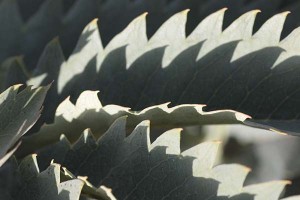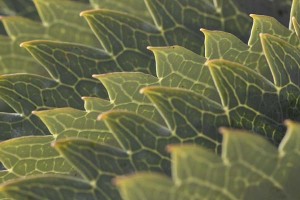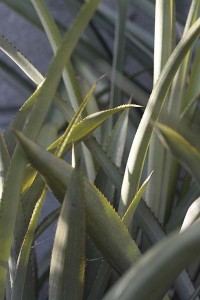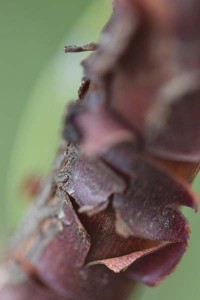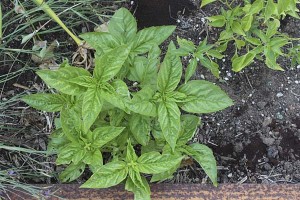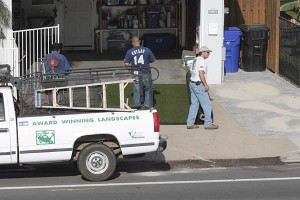After finishing my coffee and reading some of the newspaper this morning I took a quick survey around the yard.
Honey bush (Melianthus major) is a South African species that I’ve had for a couple years now. Although it responds to watering with a lot of spunky growth, it’s also good with minimal additional watering. I have two sprinkler heads in the garden, and this plant gets by on the overspray from one of the heads after it’s made the sages and tangerine tree happy.
The maroon flowers unfurl from the branch tips in spring and dry to these brown spikes. I’ve left them on the plant to help me decide if I like the way they look or not. The bed they’re in in has a lot of mounding plants, so the spikes give some vertical interest.
The leaves are heavily serrated and are the main reason for growing the plant. Here they are, with shadows, and backlit by the morning sun. They look a little fierce, but they’re actually soft, like rubber. They do have a bit of an unpleasant odor if you brush by them. Combine that fact with the plant’s eventual size–six to twelve feet–and you’ll see that it has “dramatic background plant” written all over it.
The melianthus grows next to a bromeliad that truly is nasty and spiny. (I’ve mentioned this plant before…) Pretty though, even when it’s not flowering. And it takes next to no water when grown in mostly shade.
Next to the honey bush and bromeliad, in a planting that spans two or three continents, is a young manzanita, Actostaphylos Dr. Hurd, shown here in a detail highlighting its exfoliating bark. Although one of the faster growing manzanitas–it’s grown eight inches since February–this still isn’t a plant for the impatient. Currently it’s exactly one meter tall, and will hopefully hit its design height of ten feet before I’m back diapers. Eventually it’ll make it to fifteen feet or more.
In the front of the same bed, next to a sprinkler head, are some basil cuttings that I’ve posted on before. Six weeks after planting out, the largest plant is maybe eight by eight inches and is big enough for me to consider taking an occasional snip for the dinner table. In a month I should be ready to make batches of pesto.
The final photo isn’t my garden, but looking across the street, where they’re installing plastic turf. The neighbors are responding to our new water restrictions by mixing synthetic grass with palm trees. The look will be something like the wet Hawaiian paradise they had before.
But I do worry that synthetic grass, even if it looks something like the real thing, does nothing to address people’s fundamental expectations of what a garden should look like in a fiercely dry climate. And in my most uncharitable moments I think that installing plastic grass is like treating heroin addiction with methadone. And to this gardener, installing something as dead as plastic grass lands with a thud as loud as the one created by the infamous 1978 remodel of a Sunset Boulevard mansion by a Saudi sheik that featured planters full of plastic flowers.
But hey, they’re doing what makes sense to them, and they will be reducing their water use.


